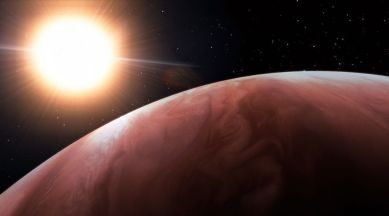This hellish exoplanet is hot enough for molten iron rain, rock vapour
WASP-76b is a planet that orbits twelve times closer to its host star than Mercury orbits the Sun.

An international team of astronomers yesterday announced they conducted a detailed study of the extremely hot giant exoplanet WASP-76 b. How hot? Well, hot enough for rocks to get vapourised and for it to rain down molten iron.
The planet orbits the massive star WASP-76, which is about 634 light-years away from our planet in the direction of the constellation Pisces. WASP-76 b orbits very close to its parent star, around 12 times closer than Mercury is to the Sun. The “puffy” planet has a mass similar to that of Jupiter, but it is more than six times larger by volume.
monthly limit of free stories.
with an Express account.
Molten iron rain
In a 2020 research paper published in the journal Nature, astronomers proposed that there could be molten iron raining down on one part of the planet. Here is how that works.
The planet is tidally-locked, meaning that one of its sides permanently faces the star that it orbits. This means that one side is constantly superheated while another side is much colder. The astronomers estimated that it is over 2,400 degrees Celsius on the dayside and about 1,500 degrees Celsius on the nightside. The massive temperature difference between the two sides can create strong winds.
These winds can go up to speeds of 18,000 kilometres per hour, transporting elements in the planet’s atmosphere from one side to the other. In the 2020 study, researchers found that iron was present in the form of a gas on the dayside while there was very little iron detected in the atmosphere on the nightside.
This could mean that the wind carries the iron atoms from the dayside to the night side. When the iron reaches the transition point between the two sides, the temperature decreases and the iron will condense into liquid drops that fall to the land.
Latest look at hell away from Earth
An international team of researchers announced yesterday (June 14) that they used the MAROON-X instrument of the Gemini-North Telescope to conduct a detailed study of the planet. They were able to identify and measure the presence of 11 chemical elements in the atmosphere of the planet. The research was published in the journal Nature yesterday.
When the temperatures are well above 2,000 degrees Celsius, the elements that would normally form rocks on Earth, like Magnesium and Iron, are vapourised and present in the form of gases in the upper atmosphere.
The presence and abundance of many of the elements discovered by the researchers on the planet match that of the composition of our Sun and the host star of the planet, like manganese, chromium, magnesium, vanadium, barium and calcium.
The presence of these elements is not random. They were formed as the product of the big band and billions of years of nucleosynthesis in the stars. Typical, scientists measure a similar composition of elements in all stars, according to the University of Montreal. But the compositions of rocky planets like ours are different because they are formed in a slightly more complex manner.